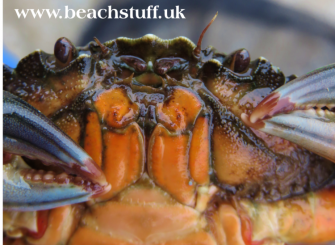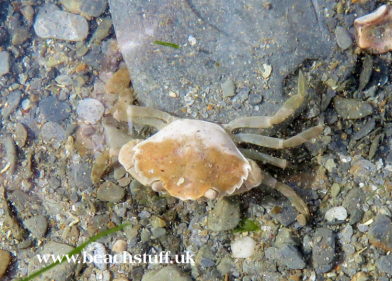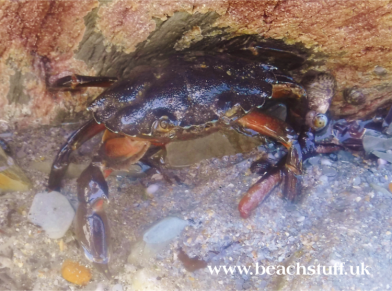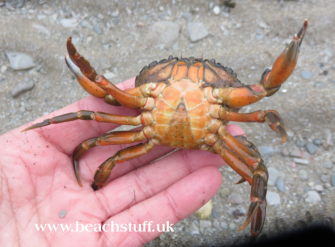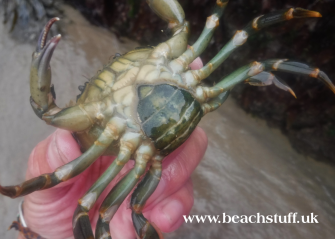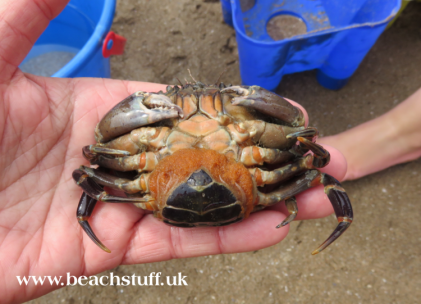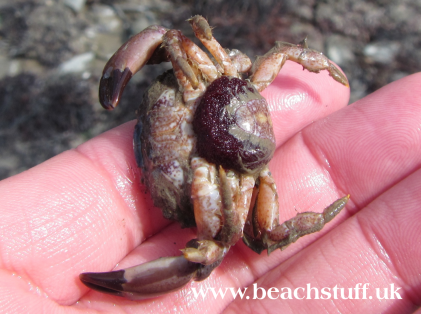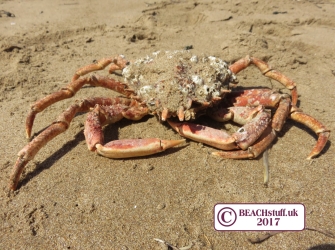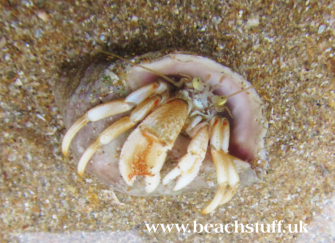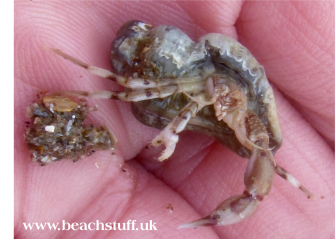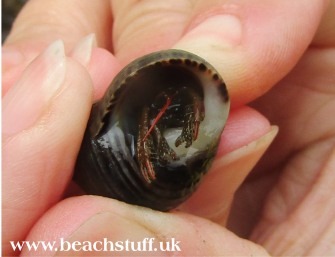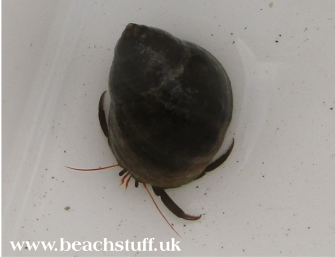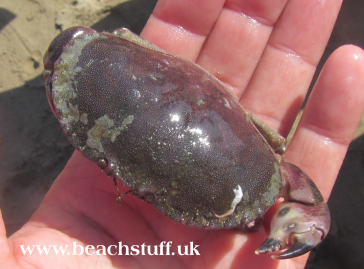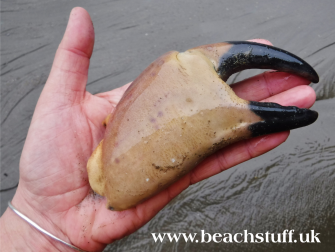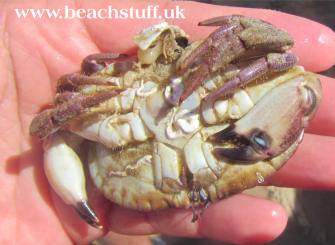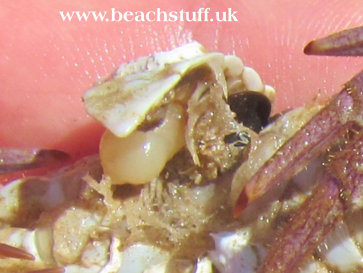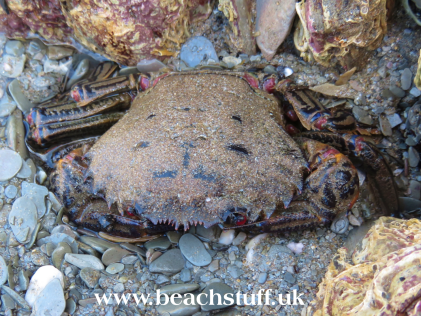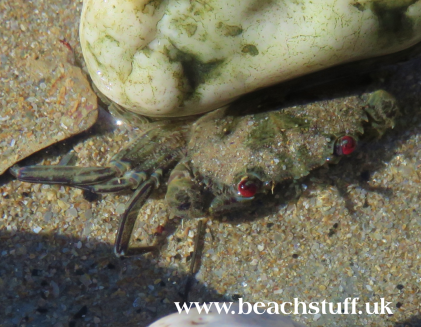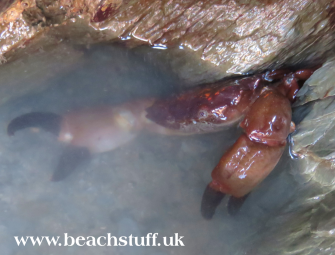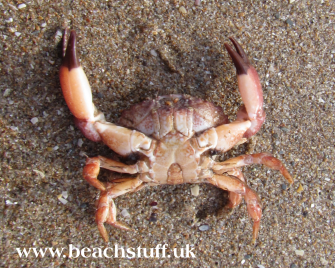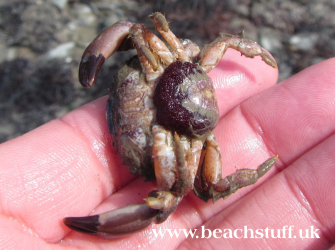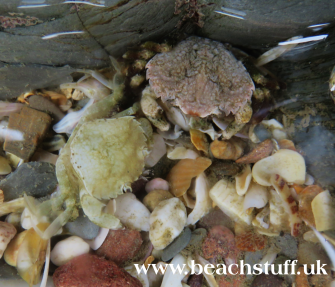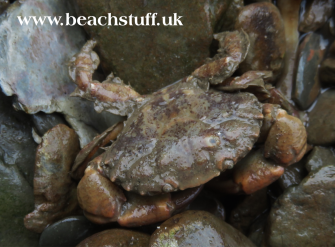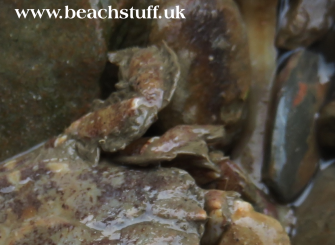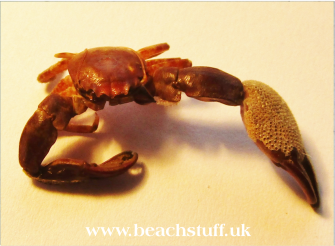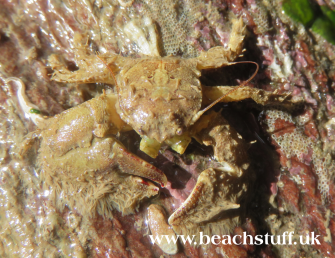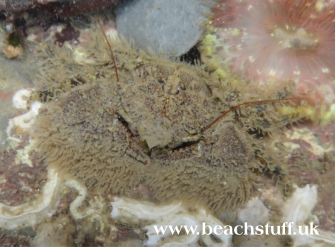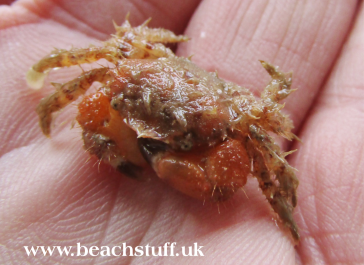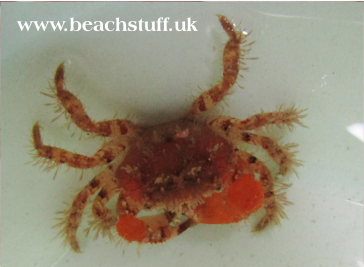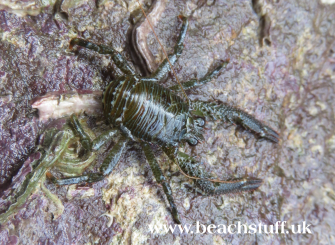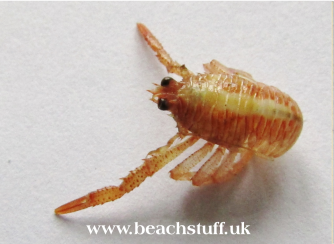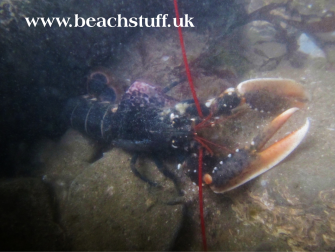
Crabs (and a lobster)
Some of the most exciting animals we find in rockpools can be crabs, if only because we don't have any other animals quite like them.
Crabs can be found in all sizes but, a word to the wise, they can sometimes be very aggressive and crabs like the velvet swimming crab can do a lot of damage to a finger or toe which comes too close for their liking.
Shore Crab
Carcinus maenas
Shore crabs are the most common crabs we tend to find alive in rockpools. They are generally green or greenish hence they are also known as the European Green Crab. They tend to eat sea snails, prawns, shrimps and worms.
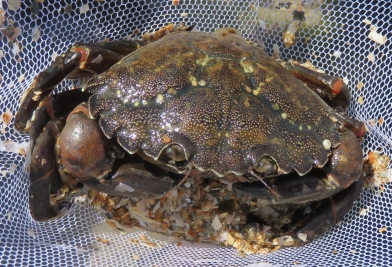
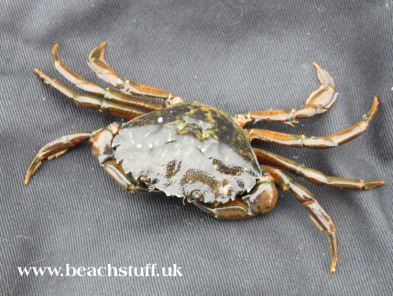
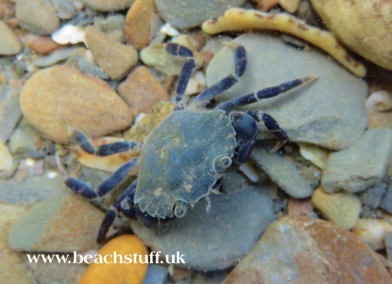
While shore crabs are usually dark green or brown/black, they can also be a range of other colours, especially when they are young. The blue one above is a rare one though!
Shore crabs like to bury themselves in the sand to hide from predators (and rockpoolers!). Have a look at the clip on the left.
Press play to watch the clip.
How to sex a crab
Sexing a crab is all about looking at the shape of the flap on the abdomen. On the male, it is long and comes to a sharp point.
On the female, it is rounded This is so that the thousands of eggs she will carry can be held underneath it. See the picture below.
A berried female shore crab. Berried is the term used for a female carrying eggs. Crabs can carry something in the region of 200,000 eggs. Below, a buried furrowed crab.
Maja squinado
This is generally the largest of the crabs we find in UK rockpools, with its long thin legs giving it its spider name. It is generally orange, but its spiky carapace collects sea weeds which means that it can hide very successfully. A shell devoid of weeds, like the two below on the left, suggests the crab recently moulted. Their shell can grow to be 20 centimetres wide which, when you add the legs, makes these crabs as big as dustbin lids.
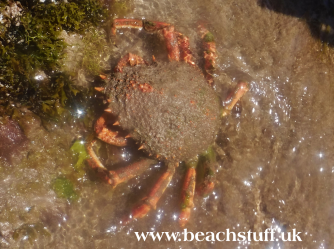
Spider crabs feed on seaweed, sea urchins and sea shells. When they have moulted and have soft shells, they tend to gather in large numbers for protection (left - huge numbers gathered onshore at low tide) and this is also the time that they breed.
Common Hermit Crab or Soldier Crab
Pagurus bernhardus
The other crabs on this page grow their own shell and moult it regularly as they grow. The hermit crab does not do this (it has a soft body) but moves into the abandoned shells of molluscs. The common hermit crab is reddish and has a large right pincer which it uses to fill the hole in the shell when in tucks up inside.
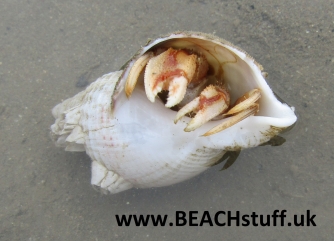
The South Claw Hermit Crab
Diogenes pugilator
This is a more unusual hermit crab than the common hermit crab. The major indicator that you have a South Claw and not a common is that the left pincer is the largest, not the right. It is often found in netted dog whelk shells, although this one pictured is in a sting winkle shell.
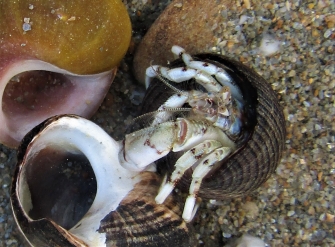
St Piran's Hermit Crab
Clibanarius erythropus
In 2016, St. Piran's Hermit crabs were found in Cornwall and Devon after not being seen here since the mid-1980s. It was once a common find. It is distringuishable from other hermit crabs by its red legs which are all of a similar length. After its rediscovery, BBC Springwatch ran a competition to give the crab a common name - St Piran was chosen as he was a hermit who survived being thrown in the sea.
Edible Crab or Brown Crab
Cancer pagurus
The edible crab's carapace is much wider than it is deep, and has a crimped edge like a Cornish pasty. The strong, wide claws are tipped with black. It is often found hiding deep in rock crevices and cannot be tempted out. Crabs are often tiny when in rock pools (bottom left) but, further out to sea, can grow to large sizes (bottom right). Edible crabs can typically live to be thirty years old.
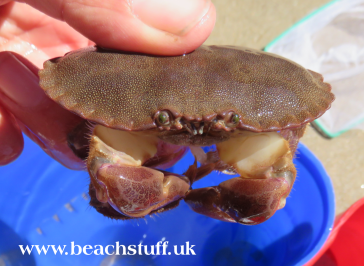
Crab hacker barnacle
Sacculina inflata
This barnacle is a parasite of crabs which can be seen as a white growth under the abdominal flap of this hapless edible crab.. When on a male crab it effectively castrates them and passes hormones which turn the crab female and infertile. On female crabs, the barnacle not only makes them infertile but lays its own eggs on them which the crab then carries.
Other species of sacculina are parasites on other crabs, Shore crabs, for example, can carry sacculina carcini.
Velvet Swimming Crab or Devil Crab
Necora puber
This striking crab is distinguishable by its bright red eyes, and deep blue striped legs. Its velvet name comes from the hundreds of hairs that cover its shell giving it a velvety texture. Its devil name comes from its red eyes and its temperament - it is an aggresive crab with sharp pincers that can do a lot of damage.
Montagu's Furrowed Crab
Xantho hydrophilis
In comparison with the shore crab, this has much larger pincers in relation to its carapace, and is generally found further down the shore. It is often confused with Risso's crab although the Risso's crab has a fringe of hair on its legs. Despite having fearsome looking pincers, Montagu's crab feeds mainly on algae.
Above: A female Montagu's crab carrying eggs (berried).
Young Montagu's form a neat rectangle when they are disturbed (below).
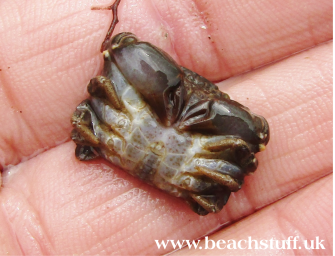
Above: A clip of a a Montagu's crab.
Moulting
Crabs lose their entire shell regularly, especially when they are young and growing. As they mature, males will moult less often but, in most species of crab, females moult annually as this enables them to mate. The moulting process can take a number of weeks but starts with the crabs taking in as much water as they can so that they swell and force their old shell to expand and split away. In the photo on the left, the newly moulted crab is on the right and its discarded smaller shell is on the left.
Risso's Crab
Xantho pilipes
Often confused with Montagu's crab (above) but has a notable fringe of hair on its legs (see wet version of this below). The carapace grows to a width of around six centimetres. Tends to be creamier in colour than the Montagu's crab..
Long-clawed Porcelain Crab
Pisidia longicornis
This is a small crab, its crapace growing to only about a centimetre in width. They feed by filtering bits of food out of the sea water around them and are generally found living underneath stones.
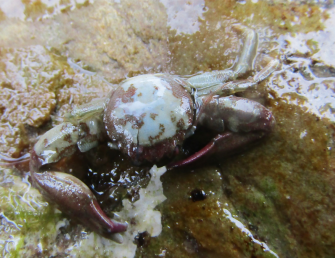
Broad-clawed porcelain crab
Porcellana platychele
Like the long-clawed porcelain crab, this crab feeds by filtering food out of the water. It can be extremely difficult to see as it is so hairy - see below for a great example of this.
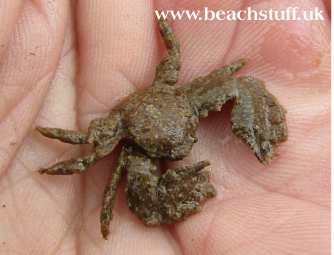
Long-legged spider crab
Macropodia rostrata
In comparison with the Common Spider Crab,this is a very small crab, the carapace only reaching 2cm in length. Like the Common Spider Crab, it gathers sea weeds on its shell and legs which serve to enable to hide effectlvely.
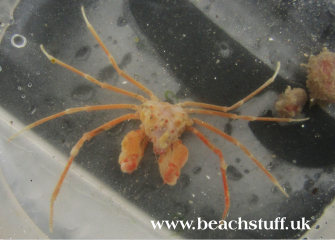
Four-horned spider crab
Pisa Tetraodon
This little crab has an array of horns on its carapace on which it collects seaweed which disguises it from predators. The carapace itself is roughly diamond shaped.
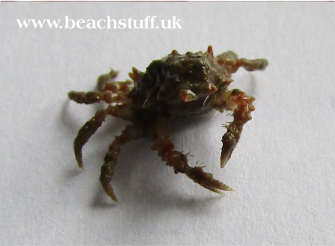
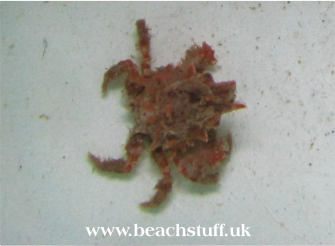
Hairy Crab
Pilumnus hirtellus
The width of this crab's shell only grows to a maximum of about 15mm. As the name suggests, this is a very hairy crab, on the shell but also on its legs.
Squat lobster
Galathea squamifera
This is not a crab (nor, in fact, a lobster) but, like the porcelain crabs above is often found hiding out under stones. The carapace can grow to up to around three centimetres long.
Common Lobster or European Lobster
Homarus gammarus
Lobsters can occasionally be found in rockpools, especially at very low tide, but prefer to be further out to sea. They tend to hide in crevices during the day and hunt at night when there are fewer predators about. They can grow to be fifty centimetres long and will feed on pretty much anything they can find, alive or dead. While crabs and lobsters are both crustaceans, they are not closely related.
